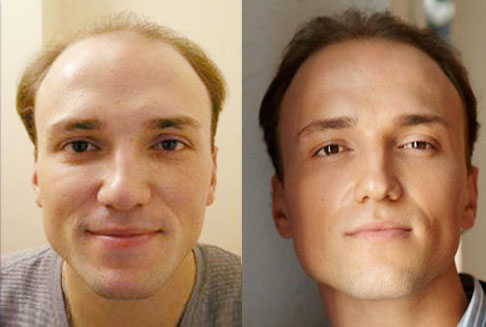Hair loss affects millions of men and women, often causing social anxiety and low self-confidence. We can change this, thanks to the advanced hair transplant technique of Dr. Marissa Milchak at Philly Hair Transplant in Philadelphia. Our hair loss treatment can help restore your crowning glory by transplanting your own natural hair to cover up bald or thinning patches. Boosting your confidence and minimizing social anxiety.


Dr. Marissa Milchak is a sought-after expert in hair transplant solutions. She consults with over 700 patients affected by hair loss annually. Her thorough understanding of both medical and surgical aspects of hair loss treatment enables her to combine both areas of expertise for the best possible outcome.
Dr. Milchak is a board-certified dermatologist, qualified and experienced in the diagnosis and treatment of hair loss and hair restoration. Her patients are always pleased with their growing results!
Hair transplants have improved dramatically in the past 15 years. Having an unnatural appearance after a hair transplant is a thing of the past when selecting the right surgeon.
During FUE or FUT surgery, our board-certified hair restoration experts remove healthy hair follicles from a donor site and transplant them into the recipient site. Once implanted, the hair blends in naturally as it grows.
The two different methods used, both under local anesthesia are:
Individual hair follicles containing between 1 and 4 hairs are transplanted from the donor area.
A strip of tissue containing multiple hair follicles is removed from the scalp. These follicles are then dissected and individually grafted onto the bald areas.
Advancement in hair transplant procedures and technology provides patients with the option for permanent hair restoration, naturally. During your consultation with our team, we discuss the difference between follicular unit extraction and follicular unit transplant as seen in the table below.
| FUE vs FUT | FUE | FUT |
|---|---|---|
| Donor area size | Broader | Smaller |
| Recovery time | Normaly over two days | Normaly Over two days |
| Graft survival rate | Over 94% | Over 94% |
| Shaving donor area needed | Yes | No |
| Number of grafts / day | Over 3000 | Over 3500 |
| Scaring | Dot-like - rarely noticable | Linear - Hidden by hair |
| Number of lifetime grafts | ~6000 | ~6000 |
| Target area natural look | Yes | Yes |
We utilize both FUE and FUT techniques. In addition, we also offer PRP, stem cell, and light therapy to treat both male and female hair loss for those patients who may not be candidates for hair transplants.
Dr. Milchak ensures that her patients are thoroughly prepared for their procedure. She provides detailed guidelines and instructions that must be followed with care to ensure the best outcome for you.
Here’s what to expect on the day of your hair transplant procedure.
It is normal to lose transplanted hair a few weeks after the procedure before new hair growth starts. This results in the natural restoration of your hair.
The surgery is effective for individuals who have enough hair in a donor site to transplant to the thinning or balding area. Unfortunately, you will not benefit from hair transplant surgery if your hair loss is caused by:
It is always advisable to seek an expert opinion from an experienced, board-certified medical professional when it comes to hair loss and restoration techniques. Dr. Milchak is dedicated to giving honest consultations and individualized treatment plans with exceptional results.
Hair loss treatment falls within the dermatology specialty. Hair is made of the protein, keratin. Each hair is anchored into the skin by a hair follicle, and as simple as it looks, hair anatomy remains complex in nature. As seen in the image below, hair is made up of two structures: the follicle (below the skin) and the hair shaft (the part that you see above the skin).

This is the part where hair begins to grow and where it is held in place beneath the skin. The structure starts in the skin’s top layer (epidermis) and extends to the second layer of the skin (dermis). The papilla tissue, at the bottom of the follicle, contains the blood vessels that nourish the hair root.
New hair is produced in the germinal matrix that can be found in the follicle. The papilla and germinal matrix are surrounded by the bulb that is at the root of the hair. The bulb contains several stem cell types that can renew themselves. It is the bulb that affects hair growth and structure during different stages of life.
This is the part of the hair that we can see. These cells aren’t alive anymore and are made up of three layers.
Interestingly, hair follicles are not solitary structures, instead, they are arranged in naturally occurring groups called follicular units. These follicular units consist of 1-4 hairs, sometimes more.
Individual healthy hair follicular units are removed from the donor site and transplanted to the recipient site. Once implanted, the hair blends in, naturally, as it grows
Hair transplants are generally considered to be safe with few serious complications or side effects. Some of the potential side effects include swelling, bleeding, and numbness after the procedure, which generally settle down after a short time. Long-term issues may include pinpoint scars, a patchy appearance, and an unnatural appearance.
Philly Hair Transplant is one of the most advanced centers for hair restoration and acknowledges that no surgery is without risk. Patients can present with individual reactions that may affect healing. Possible risks include: infection, grafts not taking, allergic reaction to anesthesia, and excessive bleeding and/or wide scarring. These risks are significantly reduced when working with a board-certified hair transplant surgeon.
Our hair significantly contributes to our identity as individuals and profoundly impacts our self-esteem and confidence. We understand this. That's why we are passionate and committed to helping you achieve your personal hair goals. Book your consultation with Dr. Milchak today at (215-545-5458).